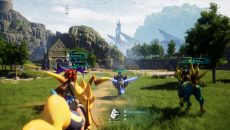2016 marks the year when the “Pokken Tournament” hype train comes to a close. A year ago, all we had was a picture of a Lucario fighting a Machamp; now, we have a full-fledged game. Being a collaboration between The Pokemon Company, Bandai Namco Entertainment and Soulcalibur producer Masaaki Hoshino, nobody knew what to expect from this game. Many “Pokemon” fans were eagerly anticipating the release date to see their beloved characters in their new-found HD glory. Now that it’s out, the question is: How does it actually stack up as a fighting game?
Well, that’s a tough question to answer, since we have never seen anything like “Pokken Tournament.” Some of the mechanics in this game are of a kind we haven’t seen before.
Perhaps the most glaring innovation is the introduction of a two-phase game. In every match, the players begin in what is known as the field phase. This form of the game is depicted through an overhead camera on the oval shaped arena, and the characters can move in all directions. Being a two player game, one player must operate using the Wii U Gamepad while the other uses a pro controller. The reason for this is because the TV will show the perspective of the player using the pro controller, while the other player’s perspective is shown on the gamepad.
This is only true for the field phase, however. Once one player lands a strong hit, the players transition into the dual phase. The perspectives matter less in this phase, since the orientation switches to a more 2D style, similar to “Street Fighter” or “Mortal Kombat.” Pokemon have different attacks in each phase: in field phase, more projectiles are available, but in dual phase, the emphasis is on combos and heavy-hitting attacks. A strong attack must also be landed to transition from dual phase back to field phase.
In every match, the player can also choose from a set of Pokemon pairs to serve as supports. Many of these Pokemon do damage to the other player, while others heal you or do something else to benefit you. You cannot use these abilities until their meter is filled, however, and only one can be used per round (one match consits of best two out of three rounds).
There is another meter in the game that is alloted to your Synergy Boost. When activated, Synergy Boost will change the Pokemon’s appearance (even allowing the Pokemon to mega-evolve, if available), make their moves deal more damage and heal the Pokemon over time. Each character also has a Synergy Boost move that opperates like a fatality in “Mortal Kombat.” These moves tend to deal large amounts of damage and, in some cases, can defeat the opponent when their life is around half.
All of these innovations can be a lot to take in. Since there is so much, “Pokken Tournament” ends up being a platform for new fans to learn fighting game basics not just for “Pokken,” but for “Street Fighter,” “Mortal Kombat,”,“Marvel V Capcom,” “Super Smash Bros,” or any other fighting game.
First of all, there is a mode called Action Dojo, which teaches the player how to perform basic combos for each character. This is preferable over “Smash,” for example, where you have to go into training mode and experiment to learn combos. There are other helpful elements in the game that teach you fundamentals, like the fighting triangle (attacks beat grabs, grabs beat shields, shields beat attacks). One could argue that the phases themselves teach fighting game basics. The emphasis on getting the first hit in field phase could be comparable to the neutral game in other fighting games, where players use their quick, long-range moves to either bait a bad move or find an opportunity to launch an attack; dual phase emphasizes combos and punish game, where you recognize a mistake by the opponent and capitalize with a large attack.
On top of being technically sound, this game is amaizingly animated. The creators did a lot to bring the Pokemon to life. Many features on these characters make the Pokemon appear as if they could actually exist in the real world – for example, the lifelike fur on Weavile, or the detail Machamp’s muscles. The animations for the Synergy Burst moves are quite the treats, as well. Like in “Mortal Kombat,” once the hit is confirmed, these moves transition into cut scenes that look very, very nice.
While this game has benefits for players who are new to fighting games, others might not be so impressed. There is a major lack of single-player content, so fans looking to play a large, in depth campaign will be disappointed. There is also a relatively small roster; the player begins the game with 14 characters, and they can unlock two others by playing the campaign. Some of these characters feel old as well, since Pikachu, Charizard and Lucario all appear in “Super Smash Bros.” as well. The game almost makes up for this by having a long list of pairs of Pokemon supports, though I personally would have liked to see some of the support characters as playable characters, such as Dragonite and Reshiram.
At the end of the day, it is hard to compare “Pokken Tournament” to anything since it’s so unlike anything that came before it. It’s certainly not perfected yet; being the first of it’s kind, the developers should be applauded for their innovation. At it’s roots, “Pokken Tournament” is a fun experience. It might not stack up with “Street Fighter V” or “Marvel V Capcom 3” yet, but hopefully this game is the first in a series that will continue to improve. Either way, if you’re looking for a good time, “Pokken Tournament” is worth picking up.



